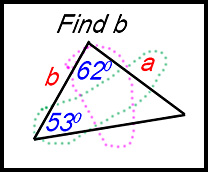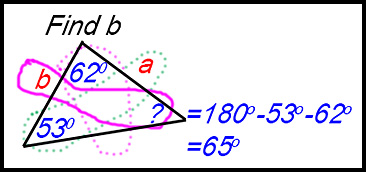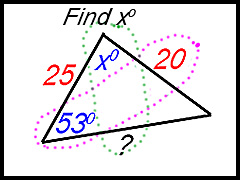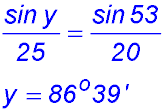Where the techniques of Maths
are explained in simple terms.
Trigonometry - non-right angled triangles.
The Sine Rule - basic format and how to apply.
- Algebra & Number
- Calculus
- Financial Maths
- Functions & Quadratics
- Geometry
- Measurement
- Networks & Graphs
- Probability & Statistics
- Trigonometry
- Maths & beyond
- Index
This page complements and extends the information and explanations in the Introduction page and in the video on the Sine Rule.
| On this page, you will find the following information: |
| 1. Comparison between the Sine Rule and the Cosine Rule. |
| 2. The structure of the Sine Rule and steps to follow. |
| 3. Difficulty 1 - sides and angles do not match up. |
| 4. Difficulty 2 - the Ambiguous Case. |
Comparison between the two rules - repeated.
As noted in the Introduction page for the two Rules:
| Sine Rule | Used when we have a triangle with:
and we have to find the size of one of these. |
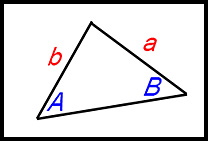 |
| Cosine Rule | Used when we have a triangle with;
and we have to find the size of one of these. |
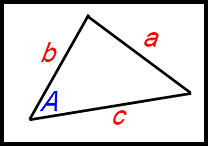 |
So to select the appropriate Rule becomes essentially the simple task of counting how many angles are indicated in the diagram or in the problem.
Proofs of each rule are provided separately for the Sine Rule and for the Cosine Rule.
The Sine Rule is generally written as  or as
or as  . Here side a is opposite the angle at vertex A.
. Here side a is opposite the angle at vertex A.
To make this relationship clearer, we can avoid the sometimes confusing symbols and simply write the ratio as we describe it as:
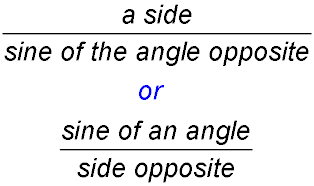
To apply the Sine Rule to any relevant problem, we remember the format of these two ratios and use the following steps -
knowing that our triangle has information about two angles and two sides and we have to find a value for one of these:
| Finding a side. | Finding an angle. | ||
| Step 1: | Identify the side-angle connections correctly by drawing an ellipse between one angle and the side directly opposite. | 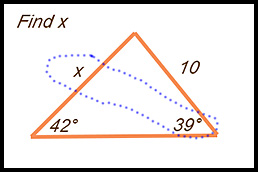 |
 |
| Step 2: | Draw a second ellipse to link the other given angle to the side opposite it. |  |
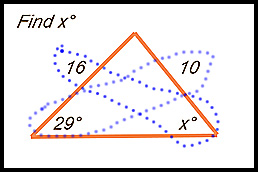 |
| Step 3: | Start with the quantity which is shown by the pronumeral - so the angle or the side whose value you have to find. | Starting with the side marked x because we are finding the length of a side. |
Starting with the angle marked x° because we are finding the angle size. |
| Step 4: | Write down the ratio shown above the table as appropriate to your problem. |
Note: side is first. |
Note: angle is first. |
| Step 5: | Write down the other ratio between known quantities with the same format. |  |
 |
| Step 6: | Multiply both sides by the term under the unknown quantity. |  |
 |
| Step 6: | Use your calculator to find the answer. | x = 9.41 | x° = 50° 52' |
Make certain you are selecting angles and sides which are REALLY OPPOSITE each other. A common mistake is to pick a side adjacent to the angle.
Two difficulties can arise when using the sine rule:
1. One pair of sides and angles do not match up as being opposite each other.
2. Two answers are possible for a required angle.
Difficulty 1: Sides and angles do not match up.
This situation is a common exam question (to trick you). There are two possibilities for such a question:
FIND A SIDE GIVEN TWO ANGLES:
1. You are given two angles but one angle is not opposite a side with a given length. The third angle is easy to find because the sum of the angles in a triangle is 180°.
Side b is opposite an angle whose size is not given.
Just calculate the third angle then use the angle sum of a triangle
( sum of angles = 180°).
Then solve as usual given the a value.
FIND AN ANGLE GIVEN TWO SIDES:
In this case, the question asks you to calculate the size of an angle but that angle does not match up with a side of known length opposite.
| 2. You are given two sides but the length of the side opposite the angle whose size you have to find is also unknown. |
The side opposite the angle we have to find (?) is of unknown length. |
Find the third angle (y°) and then use "angle sum of a triangle" to find the size of x°. |
∴ x° = 180° - = 40°21' |
Difficulty 2: THE AMBIGUOUS CASE.
(this application is not in all syllabuses (eg it is not in Standard syllabuses) so check if you need this application).
Sometimes when we use the Sine Rule to find an angle, we also need to check if the angle is really an acute angle or whether it could also be an obtuse angle. Remember that the values of a trig ratio applied to an angle could be positive or negative depending on what quadrant of the unit circle the angle is located.
As sine ratios are positive in both the first and second quadrants - so for angles less than 180° - a calculation for an angle often has to be checked further.
 |
Consider we have just used the sine rule and calculated the size of the angle at B to be 65°. The angle at C was given as 40° in the question.
As the sine ratio was positive, the angle at B could be acute (65°) or obtuse (180° - 65° = 115°). |
| If the angle at B is acute, the angle at A must be 75° (180° - 65° - 40°). |
|
 |
If however the angle at B is obtuse (115°), we would then calculate the angle at A as 25°
(180° - 115° - 40°).
As this angle of 25° is possible, there are two values for the size of the angle at B. So this is an example of the ambiguous case. |
 |
Alternately, the angle at B might have been calculated as being 35° (obviously the side lengths would have been different).
To test if an obtuse angle is possible, calculate the size of that possible obtuse angle as 145° (180° - 35°). Then add the existing angle in the question - so 145° + 40° = 185°!!!! |
| Not possible as the maximum sum is 180° for a triangle.
In this second example, an obtuse angle is not possible and there is only one value for the angle at B. |
|
In summary of the test for the ambiguous case, follow these steps:
| 1. Calculate the size of the required angle using the Sine Rule in the usual way. |
| 2. Subtract the size of the angle from 180° to obtain an obtuse angle. |
| 3. Add the obtuse angle to the other angle given in the question. |
| 4. If the sum exceeds 180°, then an obtuse angle is NOT POSSIBLE. |
| 5. If the sum does not exceed 180°, two solutions are possible for the angle.
Those values can be then be used separately to calculate the possible sizes of the third angle. |


